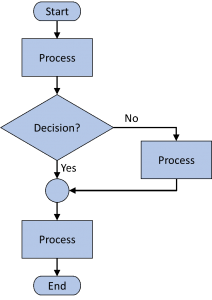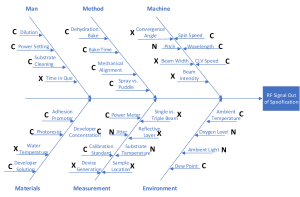Approach to Process Improvement
Many times, when managers are tasked with solving a complex problem they jump immediately into implementing various solutions to save time (and money) sacrificing a thorough understanding of the process and all the likely causes of the problem. Although this approach may initially pacify some customers and managers, it is seldom effective and usually comes back to punish the practitioner.  Alternatively, the rigorous structure of the DMAIC problem-solving methodology may require more effort planning and execution than the organization is willing to allocate.
Alternatively, the rigorous structure of the DMAIC problem-solving methodology may require more effort planning and execution than the organization is willing to allocate.
The PF/CE/CNX/SOP approach truncates the DMAIC framework into analysis, improvement, and control at a much faster pace in just four steps.
- Process Flow (PF) is a visual representation of the separate steps of a process. The elements included are the sequence of actions, materials or services entering or leaving the process, decisions required, people involved, time involved, and process measurements. The diagram helps identify waste and unnecessary steps in the process.
- Cause and Effect (CE) is also a visualization tool to help identify the possible causes of a specific problem by brainstorming in six major categories: methods, machines, manpower, materials, measurement, and environment (or mother earth if you like to use 6Ms). It is a collaborative exercise encouraging participation by all levels of the organization.
- Control, Noise, or Experimentation (CNX) is the process of labeling each of the possible causes identified in Step 2 with a plan of action. Variables considered stable and not requiring a lot of attention are labeled C (Control) and followed up with an audit to ensure an adequate system is in place to maintain required levels. Variables considered too difficult, costly, or insignificant to control are labeled N (Noise) and (initially) disregarded. Variables which need to be evaluated for their effect upon the problem are labeled X (Experiment). These variables are considered in the Design of Experiment (DOE). DOE is a systematic method of quantifying the relationship between variables affecting a process and the output upon that process.

- Standard Operating Procedure (SOP) is a collection of step-by-step instructions communicating the required method to carry out complex routine operations. Properly implemented and controlled SOPs maintain efficiency, quality, and uniformity by reducing misunderstandings and miscommunications.
The PF/CE/CNX/SOP approach encourages direct process observation, a thorough root cause analysis, and confirms (or rejects) hypothesis in a controlled manner. Potential solutions are evaluated, and control systems are put in place to sustain the improvement. The team moves at a rapid pace and communication to key stakeholders is streamlined by identifying the team status and what has been discovered.

